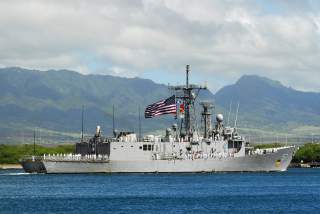The U.S. Navy Wants a New Warship to Crush the Threats of the Future
Will it happen?
The US Navy seeks a new combat-capable Frigate able to destroy swarming small boat attacks, support carrier strike groups, conduct disaggregated operations, attack enemies with an over-the-horizon missile and engage in advanced surface and anti-submarine warfare, according to a recently completed service requirements review.
Findings from a Navy Requirements Evaluation Team, delineated in a recently released Request for Information (RFI) to industry, offer a unique and unprecedented window into the weapons, technologies and broad mission scope envisioned for the new Navy ship – Frigate FFG(X)
“The Navy will consider multiple proposed designs for a lethal, multi-mission Guided Missile Frigate capable of integrated strike group operations and operating independently in contested environments using common combat system elements,” Navy spokeswoman Lt. Kara Yingling told Scout Warrior in a written statement.
Plans for the ship, as specified by the RFI, appear to exceed some of the capabilities initially envisioned for a ship which began the planning stages as merely a more “survivable” variant of the services’ Littoral Combat Ship. While that sensibility is by no means lost, many sought after characteristics for the Frigate, such and anti-submarine and surface warfare, clearly mirror or expand upon missions performed by the LCS. Anticipated weapons and tactics for new Frigate clearly appear to be a product of fast-evolving, next-generation Navy thinking.
While many of the particular weapons systems and design details have yet to be determined, and of course hang in the balance of anticipated industry offerings, the Navy is asking for a ship which can both travel in substantial aggregated combat scenarios such as Carrier Strike Groups and Expeditionary Strike Groups. In addition, it is clear that the service seeks a ship able to function autonomously as well, performing disaggregated or more independent missions.
“Concepts of employment for this type of ship will include integrated operations with area air defense capable destroyers and cruisers as well as independent operations while connected and contributing to the fleet tactical grid. Additionally, this platform must defend against raids of small boats,” the RFI states.
In terms of ship defense systems, electronic warfare technology, offensive weapons and long-range sensors, the Frigate will be engineered with very significant “blue water” combat capability.
Yingling explained that the Navy plans to engage with industry as it launches into a conceptual design phase, en route to a 2020 Detail Design and Construction contract award.
While Navy officials did not specify details of new technologies now under consideration, they did say the new examination could lead to a different kind of hull design, as well as new offensive and defensive weapons.
The prospect of stronger air defenses and enhanced survivability initiatives open the door to a wide range of offensive and defensive weaponry, such as emerging low-cost laser weapons able to incinerate incoming enemy attacks or launch offensive strikes.
The RFI states the “FFG(X) will perform its missions in complex electronic warfare and anti-ship missile threat environments, and, therefore, when available from other Navy efforts, will integrate hard-kill with advanced soft-kill systems at the combat systems level to enable the most effective offense and defense management of onboard weapons and decoy inventories.”
Existing plans for the Frigate have considered "space armor" configurations, a method of segmenting and strengthening ship armor in specified segments to enable the ship to continue operations in the event that one area is damaged by enemy attack. Discussions for Frigate technologies have included plans for ship defense technologies such as SeaRAM.
The Navy already plans for the new Frigate to be integrated with anti-submarine surface warfare technologies including sonar, an over-the-horizon missile and surface-to-surface weapons, which could include a 30mm gun and closer-in missiles such as the HELLFIRE.
Some of the over-the-horizon missiles now being considered by the Navy include the Naval Strike Missile by Kongsberg-Raytheon and the Long-Range Anti-Ship missile (LRASM) made by Lockheed and the Pentagon's research arm, DARPA. The new ship may also have seven 11-meter Rigid Inflatable Boats for short combat or expeditionary missions such as visiting, searching and boarding other ships.
At the same time the anti-submarine technologies planned for the ship are expected to include a multi-function towed array sonar, variable depth sonar to detect submarines and sensors combined with a submarine hunting MH-60R helicopter.
It is not yet known whether the Frigate will be engineered with Vertical Launch Systems (VLS) to fire larger, longer-range missiles such as a Tomahawk or Standard Missile 6.
However, that could be a possibility depending upon emerging Navy requirements for weapons on the ship, developers have said. It is certainly conceivable that these kinds of considerations could inform ongoing deliberations. The LCS hull is not engineered to accommodate VLS. However, should a different hull form be considered for the Frigate, the prospect of VLS or other kinds of ship-launched weapons could emerge.
In addition, the ship will be configured in what’s called a “modular” fashion, meaning it will be engineered to accept and integrate new technologies and weapons as they emerge such as lasers and rail guns. It certainly seems realistic that a new, even more survivable Frigate might be engineered with an additional capacity for on-board electrical power such that it can accommodate stronger laser weapons as they become available.
Overall, initial requirements concepts for the new ship appear to mirror the Navy’s much-discussed “distributed lethality” strategy. This strategic approach, in development for several years now, emphasizes the need to more fully arm the fleet with offensive and defensive weapons and disperse forces as needed to respond to fast-emerging near-peer threats.
This first appeared in Scout Warrior here.

